1 3 Of A Hexagon
| Regular hexagon | |
|---|---|
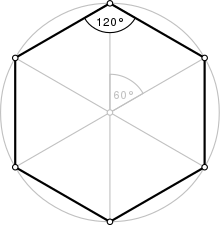 A regular hexagon | |
| Type | Regular polygon |
| Edges and vertices | 6 |
| Schläfli symbol | {six}, t{3} |
| Coxeter–Dynkin diagrams | |
| Symmetry group | Dihedral (D6), society 2×6 |
| Internal angle (degrees) | 120° |
| Properties | Convex, cyclic, equilateral, isogonal, isotoxal |
In geometry, a hexagon (from Greek ἕξ , hex , pregnant "6", and γωνία , gonía , meaning "corner, bending") is a six-sided polygon or half dozen-gon. The total of the internal angles of any simple (non-self-intersecting) hexagon is 720°.
Regular hexagon [edit]
A regular hexagon has Schläfli symbol {vi}[1] and can too be constructed as a truncated equilateral triangle, t{iii}, which alternates two types of edges.

A step-by-stride animation of the construction of a regular hexagon using compass and straightedge, given by Euclid's Elements, Volume IV, Proposition 15: this is possible as vi 2 × three, a product of a ability of two and distinct Fermat primes.

When the side length AB is given, drawing a circular arc from signal A and betoken B gives the intersection Thou, the center of the confining circle. Transfer the line segment AB four times on the confining circumvolve and connect the corner points.
A regular hexagon is defined as a hexagon that is both equilateral and equiangular. It is bicentric, meaning that information technology is both cyclic (has a circumscribed circle) and tangential (has an inscribed circle).
The common length of the sides equals the radius of the circumscribed circumvolve or circumcircle, which equals times the apothem (radius of the inscribed circle). All internal angles are 120 degrees. A regular hexagon has six rotational symmetries (rotational symmetry of gild half-dozen) and six reflection symmetries (six lines of symmetry), making upward the dihedral group D6. The longest diagonals of a regular hexagon, connecting diametrically reverse vertices, are twice the length of one side. From this it can exist seen that a triangle with a vertex at the center of the regular hexagon and sharing one side with the hexagon is equilateral, and that the regular hexagon tin be partitioned into six equilateral triangles.
Like squares and equilateral triangles, regular hexagons fit together without whatever gaps to tile the plane (iii hexagons meeting at every vertex), then are useful for constructing tessellations. The cells of a beehive honeycomb are hexagonal for this reason and because the shape makes efficient apply of infinite and building materials. The Voronoi diagram of a regular triangular lattice is the honeycomb tessellation of hexagons. It is not usually considered a triambus, although it is equilateral.
Parameters [edit]
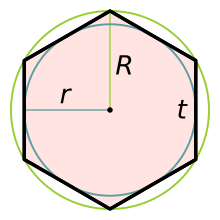
The maximal bore (which corresponds to the long diagonal of the hexagon), D, is twice the maximal radius or circumradius, R, which equals the side length, t. The minimal bore or the diameter of the inscribed circumvolve (separation of parallel sides, apartment-to-flat altitude, curt diagonal or pinnacle when resting on a flat base of operations), d, is twice the minimal radius or inradius, r. The maxima and minima are related by the same factor:
- and, similarly,
The area of a regular hexagon
For any regular polygon, the area tin likewise be expressed in terms of the apothem a and the perimeter p. For the regular hexagon these are given past a = r, and p , and so
The regular hexagon fills the fraction of its circumscribed circle.
If a regular hexagon has successive vertices A, B, C, D, E, F and if P is any point on the circumcircle between B and C, and so PE + PF = PA + PB + PC + PD.
It follows from the ratio of circumradius to inradius that the height-to-width ratio of a regular hexagon is 1:1.1547005; that is, a hexagon with a long diagonal of 1.0000000 will take a distance of 0.8660254 betwixt parallel sides.
Point in plane [edit]
For an arbitrary signal in the airplane of a regular hexagon with circumradius , whose distances to the centroid of the regular hexagon and its half dozen vertices are and respectively, nosotros have[2]
If are the distances from the vertices of a regular hexagon to whatever point on its circumcircle, then [2]
Symmetry [edit]
| Case hexagons by symmetry | |||||||||||||||||||
|---|---|---|---|---|---|---|---|---|---|---|---|---|---|---|---|---|---|---|---|
|

The six lines of reflection of a regular hexagon, with Dihhalf-dozen or r12 symmetry, guild 12.

The dihedral symmetries are divided depending on whether they pass through vertices (d for diagonal) or edges (p for perpendiculars) Cyclic symmetries in the eye column are labeled as m for their central gyration orders. Full symmetry of the regular form is r12 and no symmetry is labeled a1.
The regular hexagon has D6 symmetry. There are 16 subgroups. At that place are eight up to isomorphism: itself (D6), 2 dihedral: (Diii, D2), 4 circadian: (Zhalf-dozen, Zthree, Z2, Zone) and the trivial (e)
These symmetries express nine singled-out symmetries of a regular hexagon. John Conway labels these by a letter and group club.[3] r12 is full symmetry, and a1 is no symmetry. p6, an isogonal hexagon constructed past iii mirrors can alternate long and short edges, and d6, an isotoxal hexagon constructed with equal border lengths, but vertices alternating two different internal angles. These 2 forms are duals of each other and accept half the symmetry guild of the regular hexagon. The i4 forms are regular hexagons flattened or stretched along one symmetry direction. It tin be seen as an elongated rhombus, while d2 and p2 can be seen as horizontally and vertically elongated kites. g2 hexagons, with opposite sides parallel are also called hexagonal parallelogons.
Each subgroup symmetry allows i or more degrees of freedom for irregular forms. But the g6 subgroup has no degrees of freedom just tin can seen as directed edges.
Hexagons of symmetry g2, i4, and r12, as parallelogons can tessellate the Euclidean plane by translation. Other hexagon shapes tin tile the plane with different orientations.
| p6m (*632) | cmm (ii*22) | p2 (2222) | p31m (3*3) | pmg (22*) | pg (××) | |
|---|---|---|---|---|---|---|
 r12 |  i4 |  g2 |  d2 |  d2 |  p2 |  a1 |
| Dih6 | Dih2 | Zii | Dih1 | Zane | ||
A2 and G2 groups [edit]
The 6 roots of the simple Prevarication group A2, represented by a Dynkin diagram ![]()
![]()
![]() , are in a regular hexagonal blueprint. The two simple roots have a 120° angle between them.
, are in a regular hexagonal blueprint. The two simple roots have a 120° angle between them.
The 12 roots of the Exceptional Lie grouping G2, represented by a Dynkin diagram ![]()
![]()
![]() are also in a hexagonal pattern. The ii simple roots of two lengths have a 150° bending betwixt them.
are also in a hexagonal pattern. The ii simple roots of two lengths have a 150° bending betwixt them.
Dissection [edit]
| 6-cube projection | 12 rhomb dissection | |
|---|---|---|
 | 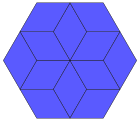 | 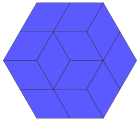 |
Coxeter states that every zonogon (a 2m-gon whose opposite sides are parallel and of equal length) tin can be dissected into i⁄2 m(1000 − 1) parallelograms.[iv] In detail this is truthful for regular polygons with evenly many sides, in which case the parallelograms are all rhombi. This decomposition of a regular hexagon is based on a Petrie polygon projection of a cube, with 3 of 6 foursquare faces. Other parallelogons and projective directions of the cube are dissected within rectangular cuboids.
| Dissection of hexagons into three rhombs and parallelograms | |||||||||||
|---|---|---|---|---|---|---|---|---|---|---|---|
| 2D | Rhombs | Parallelograms | |||||||||
 |  |  |  | ||||||||
| Regular {half-dozen} | Hexagonal parallelogons | ||||||||||
| 3D | Square faces | Rectangular faces | |||||||||
 |  |  |  | ||||||||
| Cube | Rectangular cuboid | ||||||||||
Related polygons and tilings [edit]
A regular hexagon has Schläfli symbol {six}. A regular hexagon is a part of the regular hexagonal tiling, {6,3}, with three hexagonal faces effectually each vertex.
A regular hexagon can also exist created as a truncated equilateral triangle, with Schläfli symbol t{3}. Seen with two types (colors) of edges, this form only has Diii symmetry.
A truncated hexagon, t{half-dozen}, is a dodecagon, {12}, alternating two types (colors) of edges. An alternated hexagon, h{half dozen}, is an equilateral triangle, {iii}. A regular hexagon can exist stellated with equilateral triangles on its edges, creating a hexagram. A regular hexagon can exist dissected into six equilateral triangles by adding a middle signal. This pattern repeats within the regular triangular tiling.
A regular hexagon can be extended into a regular dodecagon by adding alternating squares and equilateral triangles effectually it. This pattern repeats within the rhombitrihexagonal tiling.
 |  |  |  |  |  |  |  |
| Regular {6} | Truncated t{iii} = {6} | Hypertruncated triangles | Stellated Star effigy 2{3} | Truncated t{6} = {12} | Alternated h{six} = {iii} | ||
|---|---|---|---|---|---|---|---|
 |  |  |  |  |  |  |  |
| Crossed hexagon | A concave hexagon | A cocky-intersecting hexagon (star polygon) | Extended Central {vi} in {12} | A skew hexagon, within cube | Dissected {vi} | projection octahedron | Complete graph |
|---|
Self-crossing hexagons [edit]
There are six cocky-crossing hexagons with the vertex arrangement of the regular hexagon:
| Dih2 | Dihi | Dih3 | |||
|---|---|---|---|---|---|
 Figure-viii |  Center-flip |  Unicursal |  Fish-tail |  Double-tail |  Triple-tail |
Hexagonal structures [edit]

From bees' honeycombs to the Giant's Causeway, hexagonal patterns are prevalent in nature due to their efficiency. In a hexagonal grid each line is equally short as it tin possibly be if a large area is to exist filled with the fewest hexagons. This means that honeycombs require less wax to construct and proceeds much strength nether compression.
Irregular hexagons with parallel opposite edges are chosen parallelogons and can also tile the plane by translation. In iii dimensions, hexagonal prisms with parallel contrary faces are called parallelohedrons and these can tessellate 3-space by translation.
| Class | Hexagonal tiling | Hexagonal prismatic honeycomb |
|---|---|---|
| Regular |  |  |
| Parallelogonal |  |  |
Tesselations past hexagons [edit]
In add-on to the regular hexagon, which determines a unique tessellation of the plane, whatever irregular hexagon which satisfies the Conway criterion will tile the plane.
Hexagon inscribed in a conic section [edit]
Pascal'due south theorem (also known as the "Hexagrammum Mysticum Theorem") states that if an arbitrary hexagon is inscribed in any conic section, and pairs of contrary sides are extended until they run into, the three intersection points will prevarication on a straight line, the "Pascal line" of that configuration.
Cyclic hexagon [edit]
The Lemoine hexagon is a cyclic hexagon (one inscribed in a circumvolve) with vertices given by the six intersections of the edges of a triangle and the 3 lines that are parallel to the edges that pass through its symmedian point.
If the successive sides of a circadian hexagon are a, b, c, d, e, f, then the three principal diagonals intersect in a unmarried point if and simply if ace = bdf .[5]
If, for each side of a cyclic hexagon, the adjacent sides are extended to their intersection, forming a triangle exterior to the given side, and so the segments connecting the circumcenters of opposite triangles are concurrent.[6]
If a hexagon has vertices on the circumcircle of an astute triangle at the six points (including three triangle vertices) where the extended altitudes of the triangle encounter the circumcircle, then the area of the hexagon is twice the area of the triangle.[7] : p. 179
Hexagon tangential to a conic section [edit]
Let ABCDEF be a hexagon formed past six tangent lines of a conic section. Then Brianchon'southward theorem states that the three main diagonals AD, Be, and CF intersect at a single point.
In a hexagon that is tangential to a circle and that has consecutive sides a, b, c, d, due east, and f,[8]
Equilateral triangles on the sides of an arbitrary hexagon [edit]

Equilateral triangles on the sides of an arbitrary hexagon
If an equilateral triangle is synthetic externally on each side of any hexagon, and so the midpoints of the segments connecting the centroids of opposite triangles class another equilateral triangle.[nine] : Thm. 1
Skew hexagon [edit]

A regular skew hexagon seen equally edges (black) of a triangular antiprism, symmetry D3d, [2+,6], (2*iii), order 12.
A skew hexagon is a skew polygon with six vertices and edges but not existing on the same plane. The interior of such an hexagon is not generally divers. A skew zig-zag hexagon has vertices alternating between two parallel planes.
A regular skew hexagon is vertex-transitive with equal edge lengths. In three dimensions information technology will exist a zig-zag skew hexagon and tin be seen in the vertices and side edges of a triangular antiprism with the same D3d, [two+,6] symmetry, order 12.
The cube and octahedron (same as triangular antiprism) have regular skew hexagons equally petrie polygons.
 Cube | 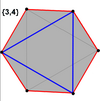 Octahedron |
Petrie polygons [edit]
The regular skew hexagon is the Petrie polygon for these higher dimensional regular, uniform and dual polyhedra and polytopes, shown in these skew orthogonal projections:
| 4D | 5D | |
|---|---|---|
 iii-three duoprism |  3-3 duopyramid |  5-simplex |
Convex equilateral hexagon [edit]
A primary diagonal of a hexagon is a diagonal which divides the hexagon into quadrilaterals. In whatsoever convex equilateral hexagon (one with all sides equal) with common side a, there exists[x] : p.184, #286.3 a principal diagonal d 1 such that
and a primary diagonal d 2 such that
Polyhedra with hexagons [edit]
In that location is no Ideal solid made of only regular hexagons, because the hexagons tessellate, not allowing the result to "fold up". The Archimedean solids with some hexagonal faces are the truncated tetrahedron, truncated octahedron, truncated icosahedron (of soccer brawl and fullerene fame), truncated cuboctahedron and the truncated icosidodecahedron. These hexagons can be considered truncated triangles, with Coxeter diagrams of the form ![]()
![]()
![]()
![]()
![]() and
and ![]()
![]()
![]()
![]()
![]() .
.
| Hexagons in Archimedean solids | |||||||||||
|---|---|---|---|---|---|---|---|---|---|---|---|
| Tetrahedral | Octahedral | Icosahedral | |||||||||
| | | | | | |||||||
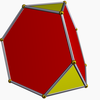 truncated tetrahedron | 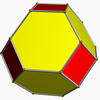 truncated octahedron |  truncated cuboctahedron | 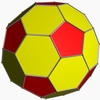 truncated icosahedron |  truncated icosidodecahedron | |||||||
In that location are other symmetry polyhedra with stretched or flattened hexagons, like these Goldberg polyhedron Chiliad(2,0):
| Hexagons in Goldberg polyhedra | |||||||||||
|---|---|---|---|---|---|---|---|---|---|---|---|
| Tetrahedral | Octahedral | Icosahedral | |||||||||
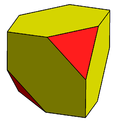 Chamfered tetrahedron | 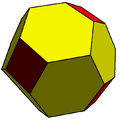 Chamfered cube | 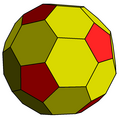 Chamfered dodecahedron | |||||||||
There are too 9 Johnson solids with regular hexagons:
| Johnson solids with hexagons | |||||||||||
|---|---|---|---|---|---|---|---|---|---|---|---|
 triangular cupola |  elongated triangular cupola |  gyroelongated triangular cupola | |||||||||
 augmented hexagonal prism |  parabiaugmented hexagonal prism |  metabiaugmented hexagonal prism |  triaugmented hexagonal prism | ||||||||
 augmented truncated tetrahedron |  triangular hebesphenorotunda |  Truncated triakis tetrahedron | |||||||||
| Prismoids with hexagons | |||||||||||
|---|---|---|---|---|---|---|---|---|---|---|---|
 Hexagonal prism |  Hexagonal antiprism | 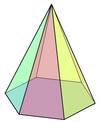 Hexagonal pyramid | |||||||||
| Tilings with regular hexagons | |||||||||||
|---|---|---|---|---|---|---|---|---|---|---|---|
| Regular | one-compatible | ||||||||||
| {6,3} | r{6,iii} | rr{6,3} | tr{6,3} | ||||||||
 |  |  | 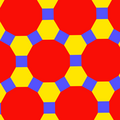 | ||||||||
| 2-compatible tilings | |||||||||||
 | 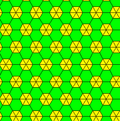 |  |  | ||||||||
Gallery of natural and artificial hexagons [edit]
-

The ideal crystalline structure of graphene is a hexagonal grid.
-

Assembled Eastward-ELT mirror segments
-
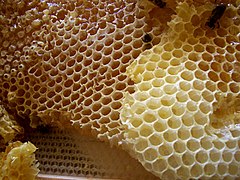
-

Micrograph of a snowflake
-

Hexagonal order of bubbles in a foam.
-

Metropolitan France has a vaguely hexagonal shape. In French, l'Hexagone refers to the European mainland of France.
-

Hexagonal befouled
-
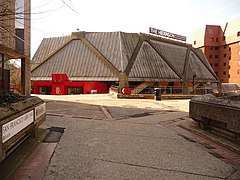
-

Pavilion in the Taiwan Botanical Gardens
-

Run across likewise [edit]
- 24-cell: a four-dimensional figure which, like the hexagon, has orthoplex facets, is cocky-dual and tessellates Euclidean space
- Hexagonal crystal system
- Hexagonal number
- Hexagonal tiling: a regular tiling of hexagons in a airplane
- Hexagram: six-sided star inside a regular hexagon
- Unicursal hexagram: single path, vi-sided star, within a hexagon
- Honeycomb conjecture
- Havannah: abstruse lath game played on a six-sided hexagonal grid
References [edit]
- ^ Wenninger, Magnus J. (1974), Polyhedron Models, Cambridge University Press, p. 9, ISBN9780521098595, archived from the original on 2016-01-02, retrieved 2015-11-06 .
- ^ a b Meskhishvili, Mamuka (2020). "Cyclic Averages of Regular Polygons and Ideal Solids". Communications in Mathematics and Applications. eleven: 335–355. arXiv:2010.12340.
- ^ John H. Conway, Heidi Burgiel, Chaim Goodman-Strauss, (2008) The Symmetries of Things, ISBN 978-1-56881-220-5 (Chapter 20, Generalized Schaefli symbols, Types of symmetry of a polygon pp. 275-278)
- ^ Coxeter, Mathematical recreations and Essays, Thirteenth edition, p.141
- ^ Cartensen, Jens, "About hexagons", Mathematical Spectrum 33(2) (2000–2001), 37–40.
- ^ Dergiades, Nikolaos (2014). "Dao's theorem on six circumcenters associated with a cyclic hexagon". Forum Geometricorum. xiv: 243–246. Archived from the original on 2014-12-05. Retrieved 2014-eleven-17 .
- ^ Johnson, Roger A., Advanced Euclidean Geometry, Dover Publications, 2007 (orig. 1960).
- ^ Gutierrez, Antonio, "Hexagon, Inscribed Circle, Tangent, Semiperimeter", [i] Archived 2012-05-xi at the Wayback Motorcar, Accessed 2012-04-17.
- ^ Dao Thanh Oai (2015). "Equilateral triangles and Kiepert perspectors in complex numbers". Forum Geometricorum. 15: 105–114. Archived from the original on 2015-07-05. Retrieved 2015-04-12 .
- ^ Inequalities proposed in "Crux Mathematicorum", [2] Archived 2017-08-30 at the Wayback Machine.
External links [edit]
![]()
Await up hexagon in Wiktionary, the free dictionary.
- Weisstein, Eric W. "Hexagon". MathWorld.
- Definition and properties of a hexagon with interactive animation and structure with compass and straightedge.
- An Introduction to Hexagonal Geometry on Hexnet a website devoted to hexagon mathematics.
- Hexagons are the Bestagons an animated youtube video nigh hexagons
| Family | A n | B due north | I 2(p) / D northward | E 6 / E seven / Eastward 8 / F 4 / G 2 | Hnorth | |||||||
|---|---|---|---|---|---|---|---|---|---|---|---|---|
| Regular polygon | Triangle | Square | p-gon | Hexagon | Pentagon | |||||||
| Uniform polyhedron | Tetrahedron | Octahedron • Cube | Demicube | Dodecahedron • Icosahedron | ||||||||
| Uniform polychoron | Pentachoron | 16-jail cell • Tesseract | Demitesseract | 24-cell | 120-cell • 600-cell | |||||||
| Uniform 5-polytope | 5-simplex | 5-orthoplex • 5-cube | 5-demicube | |||||||||
| Uniform 6-polytope | 6-simplex | half dozen-orthoplex • 6-cube | 6-demicube | 122 • 221 | ||||||||
| Uniform vii-polytope | vii-simplex | 7-orthoplex • 7-cube | 7-demicube | 132 • two31 • iii21 | ||||||||
| Uniform 8-polytope | 8-simplex | 8-orthoplex • 8-cube | 8-demicube | i42 • ii41 • 421 | ||||||||
| Uniform 9-polytope | 9-simplex | 9-orthoplex • 9-cube | 9-demicube | |||||||||
| Uniform 10-polytope | 10-simplex | 10-orthoplex • 10-cube | 10-demicube | |||||||||
| Compatible northward-polytope | due north-simplex | n-orthoplex • north-cube | n-demicube | 1k2 • 2k1 • k21 | n-pentagonal polytope | |||||||
| Topics: Polytope families • Regular polytope • List of regular polytopes and compounds | ||||||||||||
1 3 Of A Hexagon,
Source: https://en.wikipedia.org/wiki/Hexagon
Posted by: becerrawituare.blogspot.com





![{\displaystyle {\begin{aligned}A&={\frac {3{\sqrt {3}}}{2}}R^{2}=3Rr=2{\sqrt {3}}r^{2}\\[3pt]&={\frac {3{\sqrt {3}}}{8}}D^{2}={\frac {3}{4}}Dd={\frac {\sqrt {3}}{2}}d^{2}\\[3pt]&\approx 2.598R^{2}\approx 3.464r^{2}\\&\approx 0.6495D^{2}\approx 0.866d^{2}.\end{aligned}}}](https://wikimedia.org/api/rest_v1/media/math/render/svg/67e6b4ae01ba9dc79d7c7dd7fa50b2613799966c)























0 Response to "1 3 Of A Hexagon"
Post a Comment